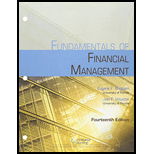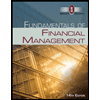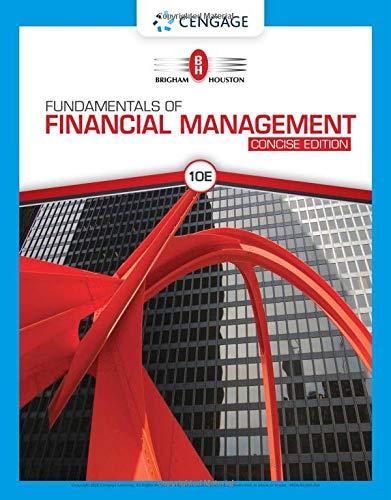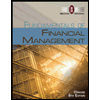
Bundle: Fundamentals of Financial Management, 14th + MindTap Finance, 1 term (6 months) Printed Access Card
14th Edition
ISBN: 9781305777118
Author: Eugene F. Brigham, Joel F. Houston
Publisher: Cengage Learning
expand_more
expand_more
format_list_bulleted
Concept explainers
Question
Chapter 9, Problem 2TCL
Summary Introduction
To explain: Whether the news and events has affected the company’s stock price.
Introduction:
Stock Price: It refers to the price of a single share of a company in the share market. The trading of shares of a company takes place in a share market. It provides the value of the company in the market in terms of total value of their share capital.
Expert Solution & Answer
Want to see the full answer?
Check out a sample textbook solution
Students have asked these similar questions
A proxy is an authorization that doesn’t allows one shareholder to vote on behalf of another shareholder.
TRUE OR FALSE
Non-Investment-grade bonds are rated at least BBB by Standard and Poor’s.
TRUE OR FALSE
Non-Investment-grade bonds are rated at least BBB by Standard and Poor’s.
TRUE OR FALSE
Chapter 9 Solutions
Bundle: Fundamentals of Financial Management, 14th + MindTap Finance, 1 term (6 months) Printed Access Card
Ch. 9.A - For a stock to be in equilibrium, what two...Ch. 9.A - If a stock is not in equilibrium, explain how...Ch. 9.A - RATES OF RETURN AND EQUILIBRIUM Stock Cs beta...Ch. 9.A - EQUILIBRIUM STOCK PRICE The risk-free rate of...Ch. 9.A - BETA COEFFICIENTS Suppose Chance Chemical Companys...Ch. 9 - It is frequently stated that the one purpose of...Ch. 9 - Is the following equation correct for finding the...Ch. 9 - Prob. 3QCh. 9 - Two investors are evaluating GEs stock for...Ch. 9 - A bond that pays interest forever and has no...
Ch. 9 - Discuss the similarities and differences between...Ch. 9 - This chapter discusses the discounted dividend and...Ch. 9 - DPS CALCULATION Warr Corporation just paid a...Ch. 9 - CONSTANT GROWTH VALUATION Thomas Brothers is...Ch. 9 - CONSTANT GROWTH VALUATION Harmon Clothiers stock...Ch. 9 - NONCONSTANT GROWTH VALUATION Hart Enterprises...Ch. 9 - CORPORATE VALUATION Smith Technologies is expected...Ch. 9 - PREFERRED STOCK VALUATION Fee Founders has...Ch. 9 - Prob. 7PCh. 9 - PREFERRED STOCK VALUATION Ezzell Corporation...Ch. 9 - PREFERRED STOCK RETURNS Bruner Aeronautics has...Ch. 9 - VALUATION OF A DECLINING GROWTH STOCK Martell...Ch. 9 - VALUATION Of A CONSTANT GROWTH STOCK A stock is...Ch. 9 - VALUATION OF A CONSTANT GROWTH STOCK Investors...Ch. 9 - CONSTANT GROWTH You are considering an investment...Ch. 9 - NONCONSTANT GROWTH Microtech Corporation is...Ch. 9 - CORPORATE VALUATION Dozier Corporation is a...Ch. 9 - NONCONSTANT GROWTH Milts Cosmetics Co.s stock...Ch. 9 - CONSTANT GROWTH Your broker offers to sell you...Ch. 9 - NONCONSTANT GROWTH STOCK VALUATION Taussig...Ch. 9 - CORPORATE VALUATION Barrett Industries Invests a...Ch. 9 - CORPORATE VALUE MODEL Assume that today is...Ch. 9 - NONCONSTANT GROWTH Assume that it is now January...Ch. 9 - Comprehensive/Spreadsheet Problem NONCONSTANT...Ch. 9 - Prob. 23ICCh. 9 - Estimating Exxon Mobil Corporation's Intrinsic...Ch. 9 - Prob. 2TCLCh. 9 - Estimating Exxon Mobil Corporation's Intrinsic...Ch. 9 - Prob. 4TCLCh. 9 - Estimating Exxon Mobil Corporation's Intrinsic...Ch. 9 - Prob. 6TCLCh. 9 - Prob. 7TCLCh. 9 - Prob. 8TCLCh. 9 - Prob. 9TCLCh. 9 - Prob. 10TCL
Knowledge Booster
Learn more about
Need a deep-dive on the concept behind this application? Look no further. Learn more about this topic, finance and related others by exploring similar questions and additional content below.Similar questions
- Moose Enterprises finds it is necessary to determine its marginal cost of capital. Moose’s current capital structure calls for 50 percent debt, 30 percent preferred stock, and 20 percent common equity. Initially, common equity will be in the form of retained earnings (Ke) and then new common stock (Kn). The costs of the various sources of financing are as follows: debt, 9.6 percent; preferred stock, 9 percent; retained earnings, 10 percent; and new common stock, 11.2 percent. a. What is the initial weighted average cost of capital? (Include debt, preferred stock, and common equity in the form of retained earnings, Ke.) b. If the firm has $18 million in retained earnings, at what size capital structure will the firm run out of retained earnings? c. What will the marginal cost of capital be immediately after that point? (Equity will remain at 20 percent of the capital structure, but will all be in the form of new common stock, Kn.) d. The 9.6 percent cost of debt referred to earlier…arrow_forward7. Berkeley Farms wants to determine the minimum cost of capital point for the firm. Assume it is considering the following financial plans: Cost (aftertax) Weights Plan A Debt .................................. 4.0% 30% Preferred stock .................. 8.0 15 Common equity ................. 12.0 55 Plan B Debt .................................. 4.5% 40% Preferred stock .................. 8.5 15 Common equity ................. 13.0 45 Plan C Debt .................................. 5.0% 45% Preferred stock .................. 18.7 15 Common equity ................. 12.8 40 Plan D Debt .................................. 12.0% 50% Preferred stock .................. 19.2 15 Common equity ................. 14.5 35 a. Which of the four plans has the lowest weighted average cost of capital? Use the Kd (cost of debt) = Y(1 - T), Kp (Cost of preferred stock) = Dp/Pp - F, Ke = D1/P0 + g formulas or I will not understand.arrow_forwardNeed use the Kd (cost of debt) = Y(1 - T), Kp (Cost of preferred stock) = Dp/Pp - F, Ke = D1/P0 + g formulas or I will not understand. Delta Corporation has the following capital structure: Cost Weighted (after-tax) Weights Cost Debt 8.1% 35% 2.84% Preferred stock (Kp) 9.6 5 .48 Common equity (Ke) (retained earnings) 10.1 60 6.06 Weighted average cost of capital (Ka) 9.38% a. If the firm has $18…arrow_forward
- Delta Corporation has the following capital structure: Cost Weighted (after-tax) Weights Cost Debt 8.1% 35% 2.84% Preferred stock (Kp) 9.6 5 .48 Common equity (Ke) (retained earnings) 10.1 60 6.06 Weighted average cost of capital (Ka) 9.38% a. If the firm has $18 million in retained earnings, at what size capital structure will the firm run out of retained earnings? b. The 8.1 percent cost of…arrow_forwardDillon Enterprises has the following capDillon Enterprises has the following capital structure. Debt ........................ 40% Common equity ....... 60 The after-tax cost of debt is 6 percent, and the cost of common equity (in the form of retained earnings) is 13 percent. What is the firm’s weighted average cost of capital? a. An outside consultant has suggested that because debt is cheaper than equity, the firm should switch to a capital structure that is 50 percent debt and 50 percent equity. Under this new and more debt-oriented arrangement, the after-tax cost of debt is 7 percent, and the cost of common equity (in the form of retained earnings) is 15 percent. Recalculate the firm’s weighted average cost of capital. b. Which plan is optimal in terms of minimizing the weighted average cost of capital?arrow_forwardCompute Ke and Kn under the following circumstances: a. D1= $5, P0=$70, g=8%, F=$7 b. D1=$0.22, P0=$28, g=7%, F=2.50 c. E1 (earnings at the end of period one) = $7, payout ratio equals 40 percent, P0= $30, g=6%, F=$2,20. Note: D1 is the earnings times the payout rate. d. D0 (dividend at the beginning of the first period) = $6, growth rate for dividends and earnings (g)=7%, P0=$60, F=$3. You will need to calculate D1 (the dividend after the first period).arrow_forward
- Terrier Company is in a 45 percent tax bracket and has a bond outstanding that yields 11 percent to maturity. a. What is Terrier's after-tax cost of debt? b. Assume that the yield on the bond goes down by 1 percentage point, and due to tax reform, the corporate tax falls to 30 percent. What is Terrier's new aftertax cost of debt? c. Has the after-tax cost of debt gone up or down from part a to part b? Explain why.arrow_forwardThe Squeaks Cat Rescue, which is tax-exempt, issued debt last year at 9 percent to help finance a new animal shelter in Rocklin. a. If the rescue borrowed money this year, what would the after-tax cost of debt be, based on its cost last year and the 25 percent increase? b. If the receipts of the rescue were found to be taxable by the IRS (at a rate of 25 percent because of involvement in political activities), what would the after-tax cost of debt be?arrow_forwardNo chatgptPlease don't answer i will give unhelpful all expert giving wrong answer he is giving answer with using incorrect values.arrow_forward
arrow_back_ios
SEE MORE QUESTIONS
arrow_forward_ios
Recommended textbooks for you
 Fundamentals of Financial Management (MindTap Cou...FinanceISBN:9781285867977Author:Eugene F. Brigham, Joel F. HoustonPublisher:Cengage Learning
Fundamentals of Financial Management (MindTap Cou...FinanceISBN:9781285867977Author:Eugene F. Brigham, Joel F. HoustonPublisher:Cengage Learning Fundamentals of Financial Management (MindTap Cou...FinanceISBN:9781337395250Author:Eugene F. Brigham, Joel F. HoustonPublisher:Cengage Learning
Fundamentals of Financial Management (MindTap Cou...FinanceISBN:9781337395250Author:Eugene F. Brigham, Joel F. HoustonPublisher:Cengage Learning EBK CONTEMPORARY FINANCIAL MANAGEMENTFinanceISBN:9781337514835Author:MOYERPublisher:CENGAGE LEARNING - CONSIGNMENT
EBK CONTEMPORARY FINANCIAL MANAGEMENTFinanceISBN:9781337514835Author:MOYERPublisher:CENGAGE LEARNING - CONSIGNMENT- Principles of Accounting Volume 1AccountingISBN:9781947172685Author:OpenStaxPublisher:OpenStax College
 Fundamentals Of Financial Management, Concise Edi...FinanceISBN:9781337902571Author:Eugene F. Brigham, Joel F. HoustonPublisher:Cengage Learning
Fundamentals Of Financial Management, Concise Edi...FinanceISBN:9781337902571Author:Eugene F. Brigham, Joel F. HoustonPublisher:Cengage Learning Fundamentals of Financial Management, Concise Edi...FinanceISBN:9781285065137Author:Eugene F. Brigham, Joel F. HoustonPublisher:Cengage Learning
Fundamentals of Financial Management, Concise Edi...FinanceISBN:9781285065137Author:Eugene F. Brigham, Joel F. HoustonPublisher:Cengage Learning

Fundamentals of Financial Management (MindTap Cou...
Finance
ISBN:9781285867977
Author:Eugene F. Brigham, Joel F. Houston
Publisher:Cengage Learning

Fundamentals of Financial Management (MindTap Cou...
Finance
ISBN:9781337395250
Author:Eugene F. Brigham, Joel F. Houston
Publisher:Cengage Learning

EBK CONTEMPORARY FINANCIAL MANAGEMENT
Finance
ISBN:9781337514835
Author:MOYER
Publisher:CENGAGE LEARNING - CONSIGNMENT

Principles of Accounting Volume 1
Accounting
ISBN:9781947172685
Author:OpenStax
Publisher:OpenStax College

Fundamentals Of Financial Management, Concise Edi...
Finance
ISBN:9781337902571
Author:Eugene F. Brigham, Joel F. Houston
Publisher:Cengage Learning

Fundamentals of Financial Management, Concise Edi...
Finance
ISBN:9781285065137
Author:Eugene F. Brigham, Joel F. Houston
Publisher:Cengage Learning
Efficient Market Hypothesis - EMH Explained Simply; Author: Learn to Invest - Investors Grow;https://www.youtube.com/watch?v=UTHvfI9awBk;License: Standard Youtube License